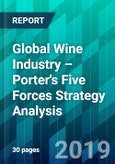The wine industry can be defined by establishments primarily engaged in manufacturing wines, brandy, and brandy spirits. This business also includes bonded wine cellars which are engaged in blending wines.
The global wine industry has been growing rapidly, crossing USD 300 billion at the end of 2017. Asia-Pacific markets are fighting hard to match up to the market leader North America, while Europe follows a close second in terms of regional markets and their market share. Changes in lifestyle and the favoring of wine over other alcoholic beverages have provided a big boost to the industry as a whole. It is expected that the industry will keep posting significant growth as the demand for wine continues to grow.
The author analyzes the Global Wine Industry in Porter’s Five Forces Analysis. It uses concepts developed in Industrial Organization (IO) economics to derive five forces that determine the competitive intensity and therefore attractiveness of a market. Porter referred to these forces as the microenvironment, to contrast it with the more general term macro-environment. They consist of those forces close to a company that affect its ability to serve its customers and make a profit. A change in any of the forces normally requires a company to re-assess the marketplace.
Table of Contents
A. Executive Summary
B. Global Wine Industry
B.1 Industry Definition
B.2 Industry Profile
B.3 Future Outlook
C. Global Wine Industry: Porter’s Five Forces Strategy Analysis
C.1 Bargaining Power of Buyers
C.2 Bargaining Power of Suppliers
C.3 Competitive Rivalry in the Industry
C.4 Threat of New Entrants
C.5 Threat of Substitutes
D. Conclusion
E. Glossary of Terms








